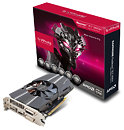- Joined
- Dec 6, 2011
- Messages
- 4,784 (1.06/day)
- Location
- Still on the East Side
Continuing the roll-out of the exciting new generation of graphics cards based on the latest GCN (graphics core next) architectures from AMD, SAPPHIRE Technology is now delivering the first members of the R7-Series, bringing many of the features of the R9-Series to users on a more limited budget.
The new R7 260X from SAPPHIRE has the budget gamer firmly in its sights as well as having many advanced features for the home or professional user. With 2 GB of the latest GDDR5 memory clocked at 1650 MHz (6.6 GHz effective), 896 stream processors and core clocks of 1150 MHz this card is no slouch. Support for DirectX 11.2 means the architecture is built to support the latest applications and to play even the very latest games at HD resolutions and above. Performance can be further enhanced by using multiple cards in AMD CrossFire on a suitably enabled mainboard.

The SAPPHIRE R7 260X features the exciting new TrueAudio from AMD, first introduced in the flagship R9 290X model. AMD TrueAudio technology brings a heightened level of audio immersion, surrounding gamers with realistic audio environments whether it is through stereo headsets or speakers. A dedicated audio processor in the GPU enables the SAPPHIRE R7 260X graphics card to deliver a richer and deeply immersive soundscape, including true to life echoes, convolution reverbs and incredibly realistic surround sound environments.
Display can also be extremely immersive, with support for three monitors in AMD Eyefinity without the need for additional active adapters. Output configuration includes Dual-link DVI-I (with VGA adapter bundled), Dual link DVI-D, Displayport 1.2 and HDMI. The HDMI 1.4a interface supports Stereoscopic 3D and both the HDMI and Displayport outputs can support the latest 4K Ultra HD displays.
The SAPPHIRE R7 260X delivers all the features of the AMD GCN architecture, including App Acceleration, AMD Image quality enhancement technology, AMD Powerplay Power management technology, AMD PowerTune technology with Boost and AMD ZeroCore Power technology.
The SAPPHIRE R7 260X is on sale now from SAPPHIRE's etail and retail partners.
View at TechPowerUp Main Site
The new R7 260X from SAPPHIRE has the budget gamer firmly in its sights as well as having many advanced features for the home or professional user. With 2 GB of the latest GDDR5 memory clocked at 1650 MHz (6.6 GHz effective), 896 stream processors and core clocks of 1150 MHz this card is no slouch. Support for DirectX 11.2 means the architecture is built to support the latest applications and to play even the very latest games at HD resolutions and above. Performance can be further enhanced by using multiple cards in AMD CrossFire on a suitably enabled mainboard.

The SAPPHIRE R7 260X features the exciting new TrueAudio from AMD, first introduced in the flagship R9 290X model. AMD TrueAudio technology brings a heightened level of audio immersion, surrounding gamers with realistic audio environments whether it is through stereo headsets or speakers. A dedicated audio processor in the GPU enables the SAPPHIRE R7 260X graphics card to deliver a richer and deeply immersive soundscape, including true to life echoes, convolution reverbs and incredibly realistic surround sound environments.
Display can also be extremely immersive, with support for three monitors in AMD Eyefinity without the need for additional active adapters. Output configuration includes Dual-link DVI-I (with VGA adapter bundled), Dual link DVI-D, Displayport 1.2 and HDMI. The HDMI 1.4a interface supports Stereoscopic 3D and both the HDMI and Displayport outputs can support the latest 4K Ultra HD displays.
The SAPPHIRE R7 260X delivers all the features of the AMD GCN architecture, including App Acceleration, AMD Image quality enhancement technology, AMD Powerplay Power management technology, AMD PowerTune technology with Boost and AMD ZeroCore Power technology.
The SAPPHIRE R7 260X is on sale now from SAPPHIRE's etail and retail partners.
View at TechPowerUp Main Site



